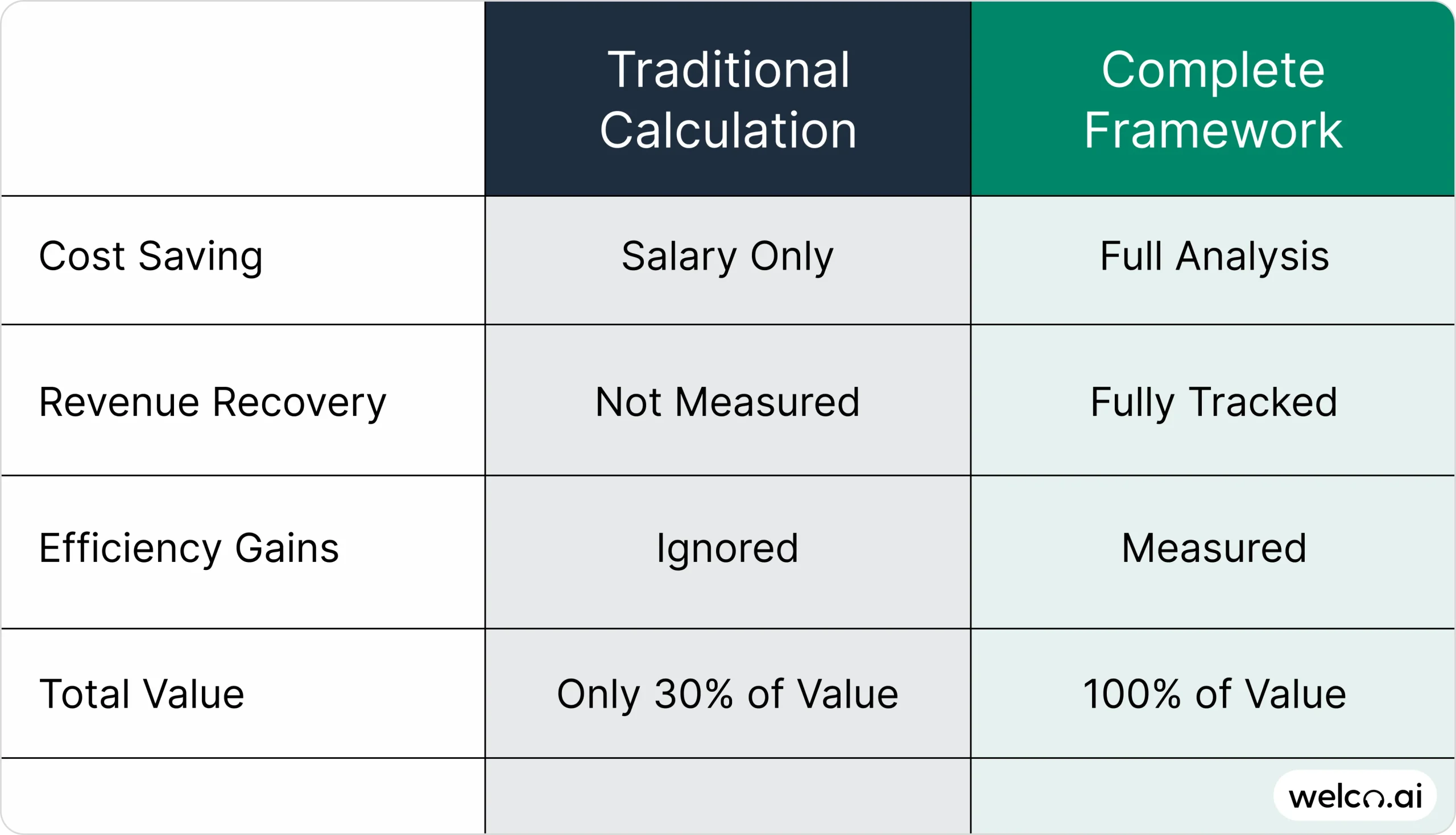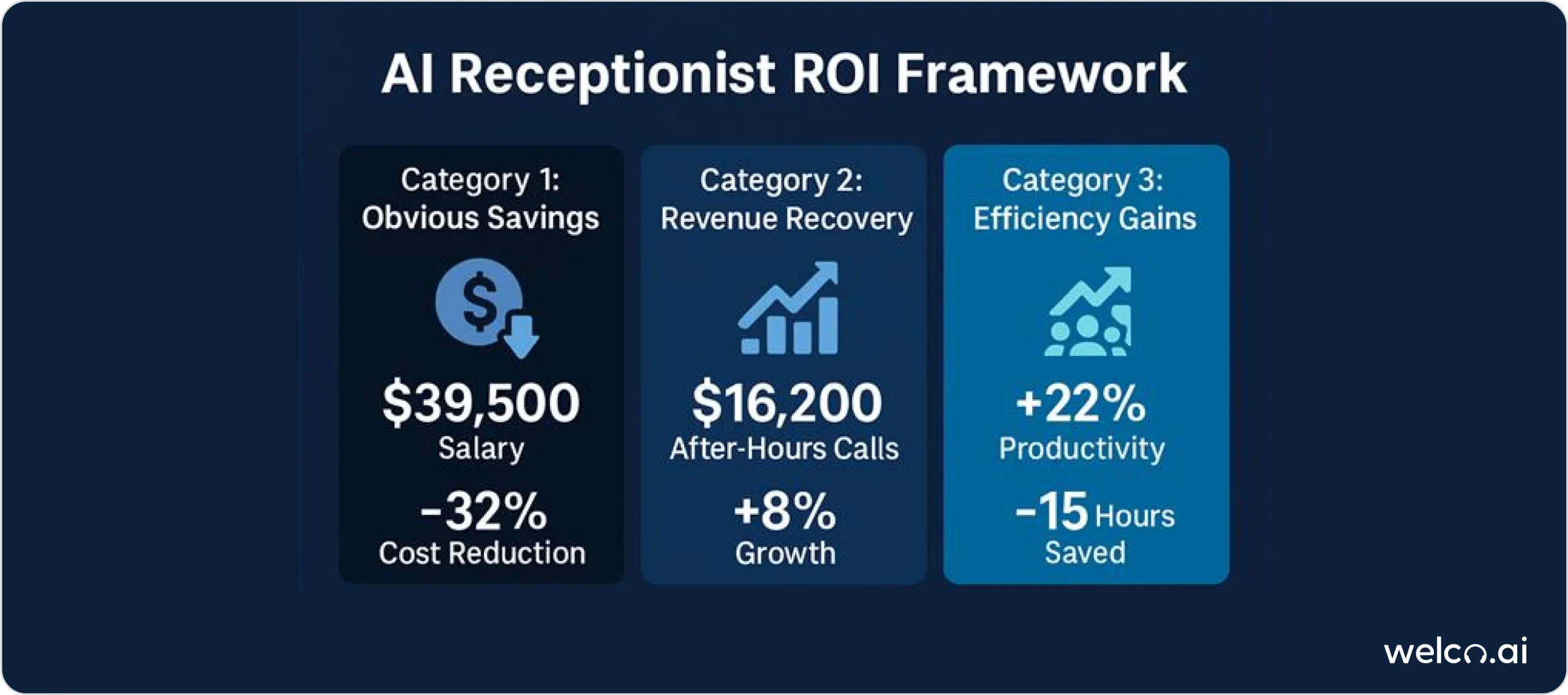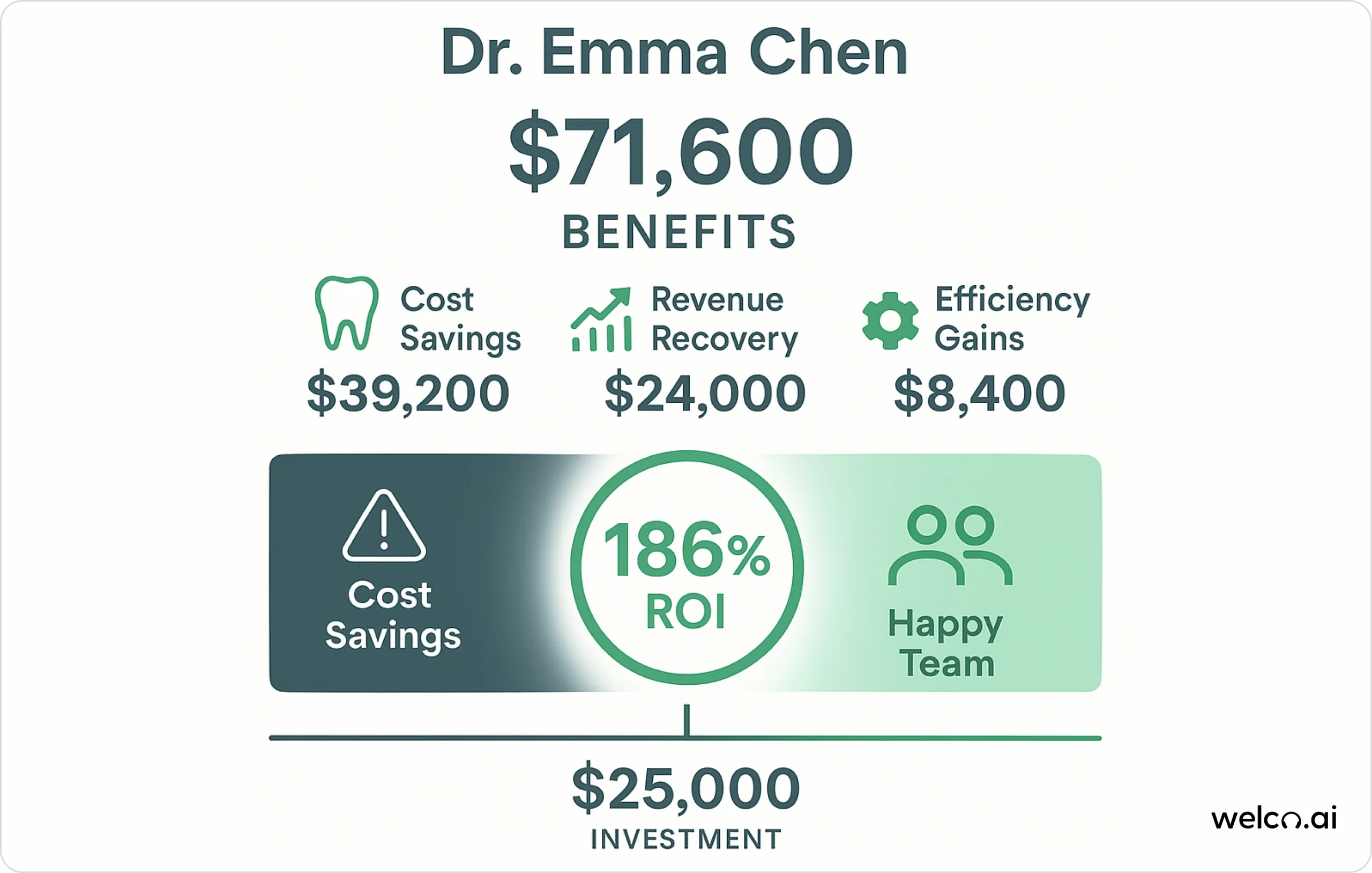- The $15,000 ROI Mistake Everyone Makes
- The Three-Category Framework That Actually Works
- Emma’s Shocking Results (And Why They’re Real)
- What This Looks Like in Practice
- The 5 Biggest Measurement Mistakes (That Cost Me $15K)
- Find Your Hidden Money Leaks
- When ROI Projections Go Wrong
- The Bottom Line
- Frequently Asked Questions
How to Actually Measure AI Receptionist ROI

I made a $15,000 mistake calculating AI receptionist ROI.
My marketing agency projected 200% returns within six months. After a year, we were barely breaking even. I was facing some very uncomfortable questions from my partners about why our “guaranteed money-saver” was still costing us more than it saved.
The worst part was the quarterly meeting where my partner asked, “So when exactly does this start paying for itself?” while staring at spreadsheets showing we were $8,000 in the hole.
I watched $8,000 disappear while our AI sat there like an expensive paperweight, handling basic calls but missing every opportunity to actually make us money.
The problem wasn’t the AI—it was how I measured AI business value.
Like most business owners, I focused only on salary replacement and completely missed where AI technology ROI actually creates value. It took Dr. Emma Chen, one of my clients, to show me what I was doing wrong.
When Emma implemented an AI receptionist at her dental practice, she expected to save about $2,200 monthly by reducing staff costs. Six months later, her actual savings were around $4,200 monthly—nearly double what she projected.
“Best decision I ever made,” she told me six months later. “I fired two part-time receptionists and my practice runs smoother than ever.”
The difference? She learned to measure the complete picture, not just salary replacement.
Here’s the ROI measurement framework that saved my reputation (and my partnership).

The $15,000 ROI Mistake Everyone Makes
The typical calculation looks like this:
- AI receptionist cost: $200/month
- Part-time receptionist salary: $2,400/month
- Projected savings: $2,200/month
This misses about 60% of the actual financial impact.
Here’s what I learned the hard way: AI implementation doesn’t just replace human tasks—it creates new revenue opportunities that didn’t exist before. A human receptionist can’t answer calls at 2 AM or handle three calls simultaneously during busy periods.
Emma’s old receptionist was missing 40 calls during lunch breaks alone. That’s 40 potential patients walking to competitors every single day.
The businesses that understand this difference are seeing 250-400% returns. The ones that don’t (like I initially did) struggle to justify their investment.
To truly understand what you’re comparing against, it’s essential to recognize the hidden costs of human receptionists that most small business ROI calculations overlook. These hidden expenses can easily double your actual reception costs beyond the obvious salary figure.
The Three-Category Framework That Actually Works
After my ROI disaster, I developed a simple framework that tracks benefits in three categories:
The Obvious Savings (That Still Add Up Fast)
This is the stuff most people calculate:
- Cost savings analysis
- Benefits reduction
- Training costs eliminated
- Turnover costs avoided
Emma’s practice saved $39,200 annually by eliminating two part-time positions. “I was spending more time managing reception staff than treating patients,” she confessed.
Revenue Recovery (The Hidden Goldmine)
This is where I completely missed the boat initially:
After-hours revenue capture: AI handles calls 24/7. Emma’s practice now books 7-9 additional appointments monthly from evening and weekend calls that previously went to voicemail. Dental practice ROI calculation typically lose 35% of after-hours calls to competitors.
Reduced no-shows: Automated appointment confirmations and reminders cut Emma’s no-show rate from 28% to 18%. Industry average for dental practices is 15-20%, so Emma was bleeding money.
Faster response times: Calls get answered in under 10 seconds instead of 45+ seconds, improving conversion rates for new patient inquiries. Law firm ROI analysis shows firms lose 30% of leads to slow response times.
Emma’s revenue recovery: approximately $24,000 annually.

Efficiency Gains That Compound Over Time
The business performance metrics that keep growing:
- Staff can focus on patient care instead of phone management
- Consistent information delivery eliminates scheduling errors
- Better data collection for follow-up marketing
Emma’s efficiency gains ROI: $8,400 annually in recovered staff time.
Emma’s Shocking Results (And Why They’re Real)
Emma’s Total Annual ROI:
- Benefits: $71,600 ($39,200 + $24,000 + $8,400)
- Investment: $25,000 (including setup and training)
- ROI: 286%
This is why Emma’s actual monthly savings ($4,200) were nearly double her initial projection—she was measuring all three categories, not just cost replacement.

What This Looks Like in Practice
Here are real numbers from businesses that got calculate ROI correctly from the start:
Dr. Martinez’s pediatric practice in Austin:
- Investment: $4,200 first year
- Revenue recovery: $28,000 (captured appointments + reduced no-shows)
- 12-month ROI: 275%
“We went from missing 20% of calls during flu season to answering everything. Parents panic when their kids are sick—if they can’t reach us, they go to urgent care,” Dr. Martinez explained.
Johnson & Associates law firm in Denver:
- Investment: $8,500 setup
- Lead capture improvement: $45,000 in additional retainers
- 18-month ROI: 350%
“Personal injury leads are worth $8,000+ each—these cases average $50,000+ settlements, making lead capture critical. Missing one call because our receptionist was at lunch cost us more than the AI system,” said partner Mike Johnson.
Greenscapes Landscaping (5 employees):
- Investment: $2,800 first year
- Peak season revenue capture: $23,000 in additional contracts
- ROI: 285%
“Spring season is insane. Before AI, we’d miss 50+ calls per week. Now we capture every lead while we’re out cutting grass,” owner Sarah Kim told me.
These numbers reflect businesses that measured ROI correctly from the start. Companies that only tracked salary replacement saw much lower returns and often questioned whether the AI investment was worthwhile.
The 5 Biggest Measurement Mistakes (That Cost Me $15K)
After helping dozens of businesses with ROI calculations, here are the mistakes that kill projections:
Mistake 1: Only Counting Salary Replacement
This captures maybe 30% of actual value. Revenue recovery often exceeds direct cost savings.
Mistake 2: Expecting Immediate Perfect Performance
AI systems improve over time. Budget for 3-6 months to reach full efficiency. I projected instant results and panicked when month 1 wasn’t perfect.
Mistake 3: Underestimating Implementation Costs
The software subscription is just the beginning. Factor in integration, training, and the learning curve. My “simple setup” turned into a $12,000 nightmare.
Mistake 4: Not Tracking the Right Metrics
Focus on response times, after-hours conversions, and customer satisfaction—not just cost per call.
Mistake 5: Forgetting the Human Factor
Staff resistance can kill ROI faster than any technical problem. My team sabotaged the system for three months because I didn’t explain how it would help them.
The human factor is often the most overlooked aspect of AI implementation. Without proper change management strategies, even the most sophisticated AI system can fail due to staff resistance. The businesses that succeed invest as much in managing the human transition as they do in the technology itself.
Find Your Hidden Money Leaks
Step 1: Calculate your current reception costs
Add up salary, benefits, training, and turnover costs. Don’t forget recruiting and onboarding expenses. Emma was shocked to discover her “cheap” part-timers cost $52,000 annually.
Step 2: Estimate revenue recovery opportunities
- How many calls currently go unanswered? (Track this for one week)
- What’s your average customer lifetime value?
- How many potential appointments could you capture after-hours?
Step 3: Factor in efficiency gains
- How much time do staff spend on reception tasks?
- What could they accomplish with that time freed up?
- What’s the cost of scheduling errors and miscommunications?
Step 4: Include realistic implementation costs
- Software costs (obvious)
- Integration and setup (usually 2-3x software cost)
- Staff training and adjustment period
- Ongoing optimization and maintenance
When ROI Projections Go Wrong
But even with perfect calculations, ROI can still disappoint. Here’s why…
Sometimes business ROI measurement doesn’t meet projections despite best efforts. Here’s what to watch for:
Warning signs after 6 months:
- Staff still bypass AI for routine calls
- Customer complaints about service quality
- Integration problems persist
- Training costs keep escalating
What to do: Focus on the human factors first, then technical optimization. Most ROI problems are people problems, not technology problems.
Real example: One client’s ROI was stuck at 150% instead of the projected 280% because staff kept bypassing the AI system. After addressing their specific fears about job security and providing better training on when to trust the AI, ROI jumped to 265% within two months.
Success in staff adoption requires more than basic orientation. Our comprehensive staff training guide provides specific methodologies for teaching teams to collaborate effectively with AI, addressing the collaboration skills that separate successful implementations from those that struggle with adoption.
The Bottom Line
AI reception ROI comes from three sources, not one. If you’re only measuring salary replacement, you’re missing most of the value.
The businesses seeing 250-400% returns aren’t just cutting costs—they’re capturing revenue that was walking out the door every day.
Start by tracking your current missed calls and after-hours inquiries for just one week. That number alone might justify the investment before you factor in any cost savings.
Most practices break even within 3-6 months when they measure correctly. The real returns start showing up in months 6-12 as the system learns and improves.
The question isn’t whether AI reception will pay for itself—it’s how much money you’re leaving on the table by waiting.
Frequently Asked Questions
My AI receptionist has been running for 8 months, but I’m only seeing about half the ROI you describe. What’s going wrong?
This is usually a measurement problem, not a performance problem. Most businesses track only direct cost savings and miss revenue recovery entirely. Start by auditing your measurement: Are you tracking after-hours calls captured? Reduced no-shows? Faster response times? Also check if staff are bypassing the AI system—that’s the #1 ROI killer. If you’re only measuring salary replacement, you’re missing 60-70% of the actual value.
I’m getting pushback from my CFO who says these ROI numbers look inflated. How do I justify a 280%+ return on investment?
I faced this exact challenge with my partners. The key is breaking down the three categories separately and showing conservative estimates. Present direct cost savings first (these are easiest to verify), then demonstrate after-hours revenue with actual call logs. Don’t present the total ROI as one number—show each category individually with supporting data. Also, compare against missed opportunity costs: what revenue are you losing from unanswered calls right now?
We’re a small business with only 3 employees. Can we really achieve the same ROI as larger companies, or are these numbers only for bigger operations?
Small businesses often see better ROI because you have fewer layers of complexity. The landscaping business example I mentioned was only 5 employees and achieved 285% ROI. Your advantage is simpler implementation and faster decision-making. Focus on revenue recovery—even capturing 3-4 additional after-hours calls per month can justify the entire investment for a small business. The key is tracking those opportunities you’re currently missing.
